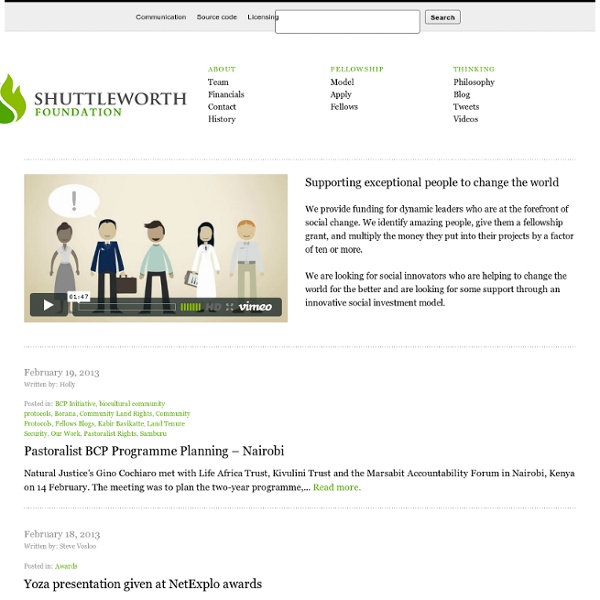



True Fans True Fans [Edit] We are able to work on the GVCS full-time thanks to the generosity of your donations. Kevin Kelly's influential essay 1000 True Fans suggested a funding structure in which 1000 supporters each donate a small amount to sustain a project they really believe in. We are looking for 1000 True Fans to each pledge $10 per month as part of the 1000 Squared Campaign. We use 100% of the True Fans funding for prototyping materials. (See the original blog post about the 1000 True Fans Campaign) And then fast forward to OSE's first ever Annual Report published at the beginning of 2013 to see the progress until the end of 2012. On this page, you can read why people like you have joined the campaign. We have also had requests for larger donation options. Contributions or gifts to Open Source Ecology are deductible as charitable contributions for Federal income tax purposes. If you do not have time but would like to offer financial support – the True Fans program is for you. Links:
Holism For the suffix, see holism. Holism (from Greek ὅλος holos "all, whole, entire") is the idea that natural systems (physical, biological, chemical, social, economic, mental, linguistic, etc.) and their properties should be viewed as wholes, not as collections of parts. This often includes the view that systems function as wholes and that their functioning cannot be fully understood solely in terms of their component parts.[1][2] Reductionism may be viewed as the complement of holism. Social scientist and physician Nicholas A. History[edit] The term "holism" was coined in 1926 by Jan Smuts, a South African statesman, in his book Holism and Evolution.[4] Smuts defined holism as the "tendency in nature to form wholes that are greater than the sum of the parts through creative evolution".[5] The idea has ancient roots. The concept of holism played a pivotal role in Baruch Spinoza's philosophy[8][9] and more recently in that of Hegel[10][11] and Edmund Husserl.[12][13] In science[edit]
Strategic Plan 2 Ambitious Abstract: This is a plan for creating the Open Source Economy (see Definition). The program begins with developing the open source Global Village Construction Set. The GVCS is defined as a minimum set of technologies necessary to create advanced civilization from locally-availabe 'dirt and twigs' with 12 people and 1 year of time starting with a container-load of GVCS tools. In the process of developing the GVCS, we will be developing a scalable, open source product development platform - the Distributive Enterprise Platform. We intend to grow the organization to 3000 facilities worldwide by 2028 by training Distributive Entrepreneurs who then take integrated production capacity back to their communities. The mission of Open Source Ecology is to create the Open Source Economy - an economy that optimizes not only production, but distribution - while promoting environmental regeneration and social justice. The OSE plan for achieving the above involves: The GVCS consists of these tools: edit
Doornkloof – the humble home of Jan Smuts, father of holism Smuts was twice Prime Minister of the then Union of South Africa, the second time during the trying years of World War II, when he was simultaneously contributing to the war effort of the allies and fending off those in South Africa who were against the war effort and wanting to support Hitler against the “English”. Born on a farm in Malmesbury in the then Cape Colony on 24 May 1870, he only started going to school at the age of 12 when his older brother died. His formidable intellect and self-discipline ensured that he caught up to his fellows within four years and went on to University at the age of 16. He graduated with double firsts in literature and science, gaining him access to a scholarship which enabled him to go to Christ's College, Cambridge, where he read law and wrote a book on Walt Whitman called Walt Whitman: A Study in the Evolution of Personality which was, for various reasons, not published until 1973.
Power Cube PowerCube II [edit] Overview The Power Cube is a modular, universal, self-contained power unit consisting of an engine coupled to a hydraulic pump, providing power from hydraulic fluid at high pressure through quick connect hoses. [edit] Details The Power Cube was designed in accordance with OSE Specifications for maximum utility. Modularity - String multiple power cubes together for increased hydraulic power. [edit] Versions Power Cube I - 18hp - built at FeFPower Cube II - 18hp - built at FeF Power Cube III - 27hp - Built at FeF Power Cube IV - 27hp - 9 Built at FeF in 2011 Production Run; replicated by Andrew Spina and Charles LiptaakPower Cube V - Tom Griffing build, delivered to FeF. [edit] Product Ecology The current iteration of the power cube is an off-the-shelf gasoline engine, but the design is intended to be as power source agnostic as possible so that the power production can be readily changed. [edit] Video (Older Power Cube Designs) [edit] Development Status Powercube 7
Open Source Ecology My Blogspot: My Matrix Solutions Affiliate link: My Zeolite Affiliate link: Winning With Code Pleading Interview w/ David Williams: The Right of Self-Determination is about Self-governing. The Artificial Womb- From the time a person leaves its mother's womb, its every effort is directed towards building, maintaining, and withdrawing into artificial wombs, various sorts of substitute protective devices or shells. The objective of these artificial wombs is to provide a stable environment for both stable and unstable activity; to provide a shelter for the evolutionary processes of growth and maturity - i.e., survival; to provide security for freedom and to provide defensive protection for offensive activity. This is equally true of both the general public and the elite. The Political Structure of a Nation - Dependency
Open Source Ecology